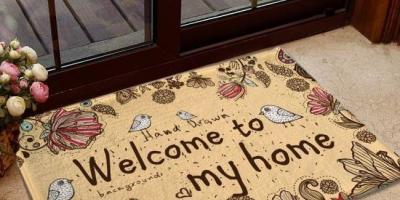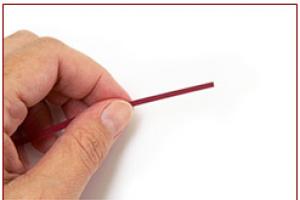Previously, beams under the ceiling solved a completely functional problem - they supported the ceiling. Nowadays this purely decorative element is most often found in interiors designed in rustic or old style. english style, in Provence, country and chalet styles. It’s a good idea to integrate beams into modern styles interior: loft, modern, minimalism, hi-tech.
Decorative ones look most advantageous in rooms with high ceilings, which dictates their placement mainly in houses with a ceiling height of three meters or more. Wooden beams under the ceiling - stylish element home decoration, emphasizing the spaciousness of the room, and in some cases carrying a functional load (for example, it is used to hide communications). Most often, beams are placed in kitchens, hallways, halls and offices.
Types of beams
Certainly, modern houses rarely decorated with real wooden elements under the ceiling. Although there are natural connoisseurs who prefer real heavy beams for ceiling decoration, as a rule, country house.
Building materials stores offer a huge selection of false beams made of lightweight and easy-to-install polyurethane. Visually, such elements are indistinguishable from natural wood, and in practice they even surpass it in some ways.

The advantages of polyurethane false beams include the fact that they:
- are not afraid of dampness, do not swell from excess moisture;
- do not crack or deform;
- very easy to attach to the ceiling (including suspended ceilings).
However, lovers of naturalness can opt for false beams made of MDF or chipboard, hollow inside. Veneers made of valuable wood species are glued onto such beams. You can find options made from lamellas. Beams come with sharp and rounded edges, U-shaped and L-shaped (to decorate joints).

Table. Comparison of polyurethane and wooden false beams.
To design a high-tech style, some designers use metal beams, however, such elements are more difficult to install and require professionals to install them.

How to make decorative ceiling beams with your own hands
Some craftsmen make beams with their own hands, which takes a minimum of time and is inexpensive. For example, in order to make false beams, you can use ordinary foam plastic, which is left over from insulating a garage or loggia.
Step 1. Cut sheets 4-5 cm thick into strips of the required width.
Step 2. Glue the strips liquid nails into a U-shaped beam.
Step 3. After setting, cut the beams into pieces of the required length.
Step 4. Cover the beams self-adhesive film under the tree (except for the side that will be glued to the wall).

Using the same technology, you can make beams from plywood or even regular boards. The boards can then be aged, covered with stain and varnish.
If you want to make beams from natural timber, you can buy edged polished timber, for example, 70x50. When choosing, be sure to check that it is smooth and dry. Then you need to treat it with stain and varnish and cut it to the required length. This is also an inexpensive and accessible option.
Decorating beams
Each interior style will require its own style of beam design.
- For classical and Victorian styles, you can decorate the beams with gold carvings, decorate them with patterns and vignettes. You can find these ready-made polyurethane beams on sale.
- White, black, brown and also colored beams will be ideal solution for modern interiors.
- For the high-tech style, the design of beams to look like metal is suitable.
- To create a country style, the wood will need to be aged.
- The rural style (country) is characterized by a distinctly rough texture.

Options for placing beams on the ceiling
False beams can be used to decorate any type of ceiling: suspended, plasterboard, regular painted, etc. With their help, you can zone a room or create such a popular decorative element as a false window on the ceiling with imitation of stained glass. Decorative beams can imitate window coverings, between which, during the work process, a canvas with photo printing, mosaics, frescoes and even mirror panels are glued. The modern European trend is very interesting, when beams go onto walls.

Beams can be decorated on top LED backlight, which will give a special decorative effect. The beams in which they are mounted look amazing ceiling lamps. All wiring in this case is hidden inside the hollow structure.
In general, beams on the ceiling will give a feeling of warmth and comfort to the living space, add zest to modern interior styles and allow you to create the necessary authenticity in public institutions such as clubs or pubs.

How to position the beams
If the room needs visual expansion, then the following points should be taken into account when arranging the beams.
- If you need to make the room wider, then the beams need to be placed on the short side.
- If you need to increase the length, the beams should be placed along the entire length of the ceiling.
- A criss-cross arrangement will give the room visual volume.
- One beam can highlight a separate area: for example, a bar counter.
The frequency of location also plays a big role. For example, if the ceiling height is very high (which happens on the first floors of buildings), placing the beams close to each other helps to reduce it a little. If the ceilings are of medium height, the beams should be mounted at a greater distance from each other. Beams can also be laid in a herringbone pattern. Attic rooms without a ceiling look especially impressive if the ceiling beams pass through the columns and are attached at the ends to the walls, creating the effect of a hut.

How to attach beams to the ceiling
The specifics of the procedure depend on the material from which the false beams are made. Let's take a closer look at each of the options.
How to glue foam false beams to a regular ceiling
This is the simplest option for placing false beams in modern apartment. If you want to decorate your kitchen or living room quickly, inexpensively and on our own, best option can not found.
Step 1. First, marks are made on the ceiling and walls to indicate the places where the false beams will be glued. The sticker areas need to be primed for better adhesion.
Step 2. Then the beam is coated with liquid nails and glued to the required place. Foam products are practically weightless, and liquid nails set literally instantly.

Some instructions advise to apply it to the wall at the same time, but if there is too much glue, the beam may begin to slide down the wall. Therefore, the golden mean must be determined experimentally.
Step 3. If the room is narrow, you can stick 2 beams along long walls rooms, and cross beams just place it perpendicular to them. Such a simple ceiling will help hide the unevenness of an ordinary concrete ceiling and it will look very advantageous.
How to quickly secure wooden beams to a wooden or concrete ceiling
This is also not very difficult or expensive to do.

Step 1. We draw lines on the ceiling for placement.
Step 2. We drill holes in the timber with a 12 mm drill no more than 0.5 centimeters deep every 30 cm.
Step 3. In the same holes we drill 8 mm holes into which we drive 120 mm self-tapping screws.
Step 4. We apply timber and mark the locations for the holes in the ceiling.
Step 5. Drill 8 mm holes on the ceiling in the marked places using a hammer drill.
Step 6. We drive chopsticks into them.
Step 7 We screw the beam.

Since the head of the screw is hidden, we cover these places with wood putty. After drying, tint with stain, then varnish. You can cover the screw heads with wooden plugs or special decorative overlays that imitate the heads of forged nails. You can attach nails to regular dowels - this is an even faster option.
If cross distribution of beams is planned, unevenness may occur at the joints. The design of these units depends on the style in which the room is decorated. If it is country, for example, then these places can be covered with leather decorative belts or large twine glued in several rows.
Installation of polyurethane decorative beams on beams
This is a professional installation method.

Decorative beam B1 made of polyurethane (wenge, cherry, oak, olive, walnut, light oak)
Step 1. For polyurethane false beams, wedge beams are made of wood, which completely correspond to the internal cavity of the beam.
Step 2. The ceiling is marked: lines are drawn along which the beams will be attached.
Step 3. The wedge bars are installed along a line every 1 meter using screws or dowels.
Step 4. When installing a false beam, polyurethane adhesive is applied to the ceiling. This is not necessary for fixation, but for a tighter fit to the ceiling so that there are no gaps left.
Step 5. The beam is tightly placed on the beams and screwed through the sides with screws.

Step 6. The screws that attach the false beam to the beam and the joints of the beams are covered with decorative leather straps with imitation rivets.
Features of the installation of beams on a suspended ceiling
To make a suspended ceiling and decorate it with decorative tanks, you should install embedded parts, similar to those installed for hanging chandeliers. Embedding for a decorative false beam is easy wooden block required thickness. It is attached to the main ceiling, and the suspended ceiling is stretched in such a way that it passes touching the lower plane of the bar. Then false beams are attached through the ceiling to the beam.

You can use fastening of beams using hangers. Suspensions are attached to the base. and after tensioning the ceiling, slits are made in the canvas. Specific actions depend on the type of material.
If the suspended ceiling has been hanging for a long time, but you want to somehow diversify the interior without dismantling the canvas, you can use external consoles with fasteners to the wall or internal bars screwed to the walls. Beams will be attached to them with self-tapping screws.
Features of the installation of beams on a plasterboard ceiling
Because plasterboard ceiling It is suspended, you can’t just attach beams to it. You will have to remember/tap the places where the frame profiles go and attach the beams to them. You can fasten it in any convenient way: with a long anchor through the beam, gypsum board and profile, or on a block attached with a self-tapping screw to the gypsum board and profile. A self-tapping screw screwed exclusively onto drywall will not hold the beam for long.

Some nuances
The joints of beams or the exit points of self-tapping screws are covered various kinds decorative overlays, among which are the following:
- camouflage with decorative rope;
- masking with wax pencil;
- masking with forged copper plates;
- decorative leather belts.
To decorate the space, you can use decorative consoles, which are sold together with beams and create an imitation of supports on the walls. If cables for lighting devices will run inside the polyurethane beam, they must be hidden in corrugated protection.
Video - Installation of wooden decorative beams on the ceiling
This way you can get a very beautiful unusual interior with an emphasis on wooden beams under the ceiling. This interior does not require a large investment of money, and you can fix the beams with your own hands literally within a few hours.
Once upon a time, ceiling beams were a necessary architectural element in the tradition of many peoples. The construction of spacious village houses, temple domes, theater vaults and long covered galleries could not have been done without them. Today, ceiling beams in the interior are rather a decorative element that reflects a certain style. Often they are multifunctional and practical, but in order for false beams to become a highlight of the design, it is important to follow the recommendations of experts.
Children's bedroom design with wooden beams

Decorative beams on the ceiling in the interior

Kitchen design with flowers and decorative beams
Decorative and functional beams: what is the difference?
Wooden and metal lintels are part of the structure of a roof, ceiling or roof of complex shape. It is impossible to build an attic, large terrace or extension without them. In this case, they carry an important functional load.
The main task when decorating a house with ceiling beams is to give the rough logs the most “lived-in” appearance. It is important that the atmosphere of the living room, hallway or recreation area with flights of stairs looks homely and hospitable.
Modern decorative ceiling beams in the interior look like wood, although they are made from composite and polymer materials. Most often they are hollow inside, and this good opportunity hide wiring and pipelines, secure lamps or brackets for suspended structures. In this case, they carry more of a practical load than a functional one, and false wood in the interior is very popular today.
Wooden lintels can be adjacent to the ceiling, form a separate lattice, or be a support for connecting inclined planes, as in the photo of the ceiling with beams of the original design.

Living room design with corner sofa, paintings on the wall and decorative beams

Apartment design with decorative beams
Interior styles where beam structures are most appropriate
Today it is customary to build houses with an aesthetic connection to a certain style, so that they look like an old “family estate”, and not like a new unfurnished building.
The most popular are buildings in the spirit of Provence, where the floors are made of light wood or covered with whitewash. In a Provence style kitchen, it is appropriate to decorate with garlands of garlic and onions, suspended from the beams with dry bouquets of lavender and spicy spices.
The natural color of dark wood is used in the style of a mountain chalet from the Swiss Alps. This style is especially relevant in buildings mansard type with a habitable attic space. And although the ceilings here are the basis of the roof, they are used for insulation and decoration in all possible ways.
The Japanese style was initially focused on collapsible houses, since the elements often destroyed the buildings of the poor and rich islanders of the easternmost ridge. The beam floors were easy to construct and dismantle after the tsunami and earthquake. This style has taken root all over the world, and decorative ceiling beams remain an indispensable attribute of a recognizable minimalist interior, where a tribute to Japanese culture is noticeable.

Stretch ceiling with beams in the middle with a chandelier

Bright white design combined living room and kitchen with decorative beams

Balcony design in cream color
Loft is the reformatting of non-residential premises into large-area urban housing. Metal or concrete floors, open communications, roughly painted or aluminum corrugated beams.
IN classic interior Only well-treated wood is used, carved, varnished or painted. Neat beams on the ceiling in a classic or traditional interior look light and elegant. The color of the wood should match the shade of the furniture and joinery.
Another classic version– ceiling beams and floors made of the same material against the background of white walls. A similar solution is often practiced in imitation of retro or country style.
Beam structures are widely used in high-tech style - as the basis for original lighting in the kitchen or living room.
A unique design can be created in the decor to suit any historical style, if the use of decorative beams on the ceiling is structurally justified.
Please note: The owners of some buildings try to hide the structural beam base with suspended or suspended ceilings. This is impractical, since you will have to give up a significant part of the ceiling height. It is better to think about their decor, even upholstering them with fabric between the painted wooden beams in the bedroom or finding another option.

Living room design with suspended ceiling and TV

Wooden partitions in the kitchen interior
There is no point in hiding beam structures in nautical style, if the house is designed as a wardroom. They fit perfectly into bungalow, eco and ethno styles.
English-style houses have a lot of natural wood, including ceilings divided into squares with niches. This solution will emphasize the sophistication of the aristocratic finish. It is possible that old substrates will have to be renewed and varnished.

Decorative partition in the kitchen

Light kitchen design with brick walls

Bright white kitchen with wooden beams
Imitation of wooden beams
Natural wood today is an expensive luxury, and massive structures made from natural material are very heavy. They create additional load on the foundation and walls; there are problems with installation and delivery due to their impressive weight. Moreover, from high humidity they can be "led".
Manufacturers of building materials have offered a convenient budget alternative made from polymer materials. The design of false beams, which are hollow inside, is not inferior to products made from natural wood, which have to stand for several months to reduce humidity.
Advantages of polymer decorative beams on the ceiling:
- moisture resistance;
- fire resistance;
- attractive price;
- relatively light weight;
- large selection of textures and shades.
In terms of strength and some other indicators, decorative beams are even superior to wood. They have an undeniable advantage - the ability to imitate any type of wood with a natural texture of various shades. For example, wenge-colored false wood in the interior, in harmony with eco-veneer doors, furniture and laminate flooring of the same luxurious chocolate color with a reddish tint.

Bathroom design in mustard color

Room design in mustard color with wooden beams
Leafing through catalogs from manufacturers, it is easy to notice that there are different decorative beams for ceilings:
- with the effect of varnishing and painting;
- with cracks and imitation of aging;
- smooth (polished) and “rough” processing.
In such products, everything is thought out for ease of fastening, and natural wood is difficult to install in a hidden way. U-shaped false beams – The best way hide communications in a bathhouse or sauna, in residential premises in loft, country style or in classic-type buildings.
L-shaped pseudo-beams are also produced, which are laid along the perimeter of the ceiling, the goal is the same - to hide pipes and wires, and imperfections in the articulation of surfaces. You can also build a rectangular imitation with your own hands to hide defects in the joints of floor slabs in an apartment.
False plasterboard beams are covered with film materials that imitate wood. This design is visually no different from the original, as in the photo.
Natural wood is preferred in houses made from natural, environmentally friendly materials. The fact is that when everything in the house is made of wood, it reacts equally to temperature changes or changes in humidity levels - it “breathes”. If some of the structures are made from building materials that are not as ductile as natural wood, additional load will be created, especially during primary shrinkage or during minor seismic factors.

Stone wall in the interior of the living room

Rustic room design

Wooden partitions in the interior
Color selection
Wood with high decorative qualities is considered to be the most in demand for interior decoration:
- rosewood (wenge);
- nut;
- cherry;
- ebony;
- oak (bleached and stained);
- ash;
When imitation wood cutting is used in synthetic analogues, it is possible to enhance natural shade or "whiten".
The color of the wooden beams on the ceiling in the interior is selected to match the overall design concept.
TABLE (Classic options)

House design with wooden partitions

Corridor design in white
A good example in the photo is the design in village house white.
Advice. When choosing a color, keep in mind that dark wood it looks heavier, white - almost weightless.
Colored ceilings should be in harmony with the main tone in the interior. Contrasting designs seem to “break up” the space; this is good for spacious rooms with high ceilings.
If the interior design turns out to be expensive, but a little nondescript and faceless, you can transfer all the attention to the upper plane, which will become the “highlight” of the decor, as in the photo.

Decorative beams in the interior of the house

Option for using decorative beams for the ceiling

Living room interior with decorative beams
Decor and aesthetics of ceiling structures
There is no point in hiding well-processed wood under the ceilings; it is better to give the interior with beams more importance in the design concept:
- Jumpers between columns or pilasters perfectly hold ceiling structures. To mitigate the shortcomings of the old building, it is better to reorganize the room using zoning techniques. Decorative beams at the top will help break up a large room into a kitchen block, dining area and reception area, as in the photo.
- In a room with a pyramidal or domed ceiling, decorative designs will help achieve the “open sky” effect if the background is light blue.
- A stretched glossy canvas behind the ceilings will add depth to the space.
- Beam structures with different patterns will help you create an inimitable interior - herringbone, checkered, triangles, hexagons.
- The floors will serve as the basis for reliable fastening of suspended structures:

- It is easy to hide defects in the articulation of surfaces behind the ceiling decor. Complex design with lintels will hide a leaking ceiling that could not be repaired in the usual way.
- A low ceiling in the kitchen can be effectively enhanced with ceiling beams, bar counter and hanging modules and other elements for placing dishes and kitchen utensils. It will look natural, like it once did in village houses.
- The interior of the attic looks most organic, where the lintels carry a decorative load. When the room is spacious, the periodicity of wooden beams gives a certain orderliness and meaning. It's better when all wooden decor one shade.
- A simple ceiling design with beams in a country house always looks very practical. This is a lot of additional possibilities for storing and placing kitchen utensils and small items. Various brooms and bundles, bags and bundles, hooks and nails were traditionally hung around the perimeter for temporary and permanent storage of anything.
- Decorative beam structures in the bedroom are not appropriate in every style. But canopies and other textile decor have long been attached to them. Mirrored ceilings with black lacquered logs in the sleeping area look extravagant and elegant.
- Beam lintels are also used to decorate a mini-pool, a spacious bathroom or bathroom. In this case, false beams made of polymer materials that imitate wood are recommended. They are not afraid of high humidity, but it is convenient to hide pipes and electrical wiring behind false wood in the interior. If desired, the internal grooves can be made sealed.
- In a teenager’s room, the interior with wooden beams can be advantageously decorated with LED strip or garlands. Older students love artificial lighting and twinkling lights. Such decor can become a source of special pride; teenagers willingly show off the original furnishings to their friends.
ABOUT self-installation We offer a video of decorative beams.
Video: Installation of decorative beams
Modern designers manage to bring to life even the most bold ideas, so today a ceiling with beams can fit quite harmoniously into both city apartment, and to a country house.
This is possible thanks to diversity existing varieties beam materials: natural wood, metal, polyurethane, plasterboard, etc.







Types of ceiling beams
Natural wood beams
Wooden beams are made mainly from cedar, ash, larch, less often - from pine and oak (due to the softness of the first and the appearance of cracks during drying on the second). For greater strength and also decorative purposes they are covered with paint or stain of almost any shade, or with special mixtures that create the effect of antiquity. It all depends on the style. So, wooden beams on the ceiling fit perfectly into country style, eco-style, Provence style and even classics. With them, the room looks solid, cozy, and harmonious.
Depending on the interior design tasks, the location of the beams is selected. It is worth saying that if it is planned in advance to equip the house with wooden beams, then this must be taken into account at the design stage of the building. In the future, such calculations will make it possible to correctly distribute loads, rationally conduct wiring, etc.







So, beams can be placed directly on the ceiling, below the ceiling with fastening on opposite walls, on the ceiling with a transition to the wall. A ceiling with beams can serve as a guide when zoning a room. For example, a beam can be located at the junction of zones along the entire length of the room or in the center of the room, say, above the rest area. Usually in such cases the beams are equipped with lamps.
Metal beams
It is clear that wooden beams on the ceiling are an expensive proposition. In addition, they are not always suitable for the premises from a technical point of view. However, for connoisseurs of this design idea there is always an alternative way out. For example, metal beams. They are optimal for urban styles: hi-tech, loft, etc.
Metal beams on the ceiling in the interior are in perfect harmony with such characteristic features similar styles, such as clarity of lines, strength of forms, minimalism in the setting. Depending on the basic color scheme of the room and the desired effect, they can be coated with steel, black, white and other suitable shades.





Polyurethane and plasterboard beams
So-called false beams are mainly created from plasterboard and polyurethane. They have U-shape, light weight, low cost. The advantages of such beams include ease of installation. Thanks to the wide color scheme and variety of textures, they can even imitate wooden beams on the ceiling.
Polyurethane and plasterboard beams can fit into absolutely any style. The most important thing is to decide on the location and color.




Due to the fact that the structure of such beams is hollow inside, they are very often used to disguise wires, cables, pipes and other elements.
Color and location of beams
Beams on the ceiling in the interior in very rare, one might say exceptional, cases go unnoticed. Usually this design element is used to add texture, relief, and style to the room. This can be achieved through the play of color and by choosing the location of the beams.
In the living room, you can use a parallel arrangement of beams in a color contrasting with the ceiling.









Beams of color look no less advantageous natural wood, matching the color of the ceiling. In the living room or bedroom, a special effect can be achieved by laying the beams in a lattice or herringbone pattern. A beamed ceiling can turn even an attic into a cozy nest. Today, designers quite often resort to this method of designing uneven attic ceilings, creating real architectural masterpieces.
Speaking about the shades of ceiling beams, one cannot help but dwell on the opportunities that the existing color palette. After all, you can give up the classic shades and allow yourself to bring bright colors. The color of the beams can be combined not only with the color of the walls, but also with the color of textiles and other decorative elements. Therefore, rich blue beams can contrast with a white ceiling and be combined with blue curtains. Or the beams on the ceiling in the interior, along with the main tone of the ceiling, can be painted dark blue in contrast to a completely white bedroom. To achieve coziness and comfort, it is possible to bring any ideas and plans to life.
Useful uses of beams
A ceiling with beams can serve not only as a kind of addition to the interior, but also as a useful element.





So, on the beams all kinds of lamps and room lighting look quite original. Lighting items can be of any shape, size and style, as long as they match the strength of the beams. If the beams are wooden, then there are no restrictions. Polyurethane or plasterboard structures may require small calculations.
In the kitchen, beams can be adapted for drying medicinal herbs, for hanging kitchen utensils.
If the beam has high strength, for example, is made of solid wood or metal, and is firmly attached to the ceiling or walls, then it can be used to install a swing or a cradle for a baby.
We associate wooden beams on the ceiling with something ancient; we immediately remember rustic comfort, the warmth of the stove, and the smell of fresh grass. It is with the help of decorative ceiling beams that many today try to decorate their home, give it originality and comfort.

Why decorative beams are used for ceilings in modern interiors, and what the features of a beam ceiling are, our article will tell you.
Ceiling beams in a modern interior
Why are ceiling beams used in the interior?
In addition to originality, wooden ceiling beams can also carry a functional load:

- Hollow beams (false beams) allow you to mask various communication lines running along the ceiling in the house. They can also be used as boxes for mounting ceiling lights.
- If you look at it from a design point of view, a ceiling with wooden beams can advantageously emphasize the height and overall volume of the room. For excessively high rooms that lack coziness because of this, placing beams at a lower level will normalize the perception of space and make it more comfortable.
For attic premises By decorating a pitched ceiling with wooden beams, you can bring some order to the interior and make it more harmonious.
Design diagram of false ceiling beams
Styles that go with ceiling beams
Beams, contrary to popular opinion, are suitable for many styles: best, of course, for ethnic styles and, under certain circumstances, for a host of others, even modern high-tech.
For interiors with a historical “classic” slant, decorative ceiling beams decorated with carvings, vignettes, and paintings are best suited. It would be appropriate to paint the beams in silver or another delicate shade. For strict “classics”, smooth varnished beams - white or dark - are suitable.
Ultra-modern styles, such as loft and hi-tech, can be decorated using beams in metallic shades.

In rooms in a rural style, also known as “country” style, it is better to use beams for the ceiling with an aging effect. Moreover, the color of the beams can be either light wood or dark wood tones. Here, the texture and roughness of the beams, inherent in elements that are in long-term use, comes to the fore.
For the French rural Provence style, on the contrary, it is better to choose more elegant beams - light and neat.
Ceiling beams in wooden house often used as ceiling supports
Positioning of ceiling beams in the interior
Since beams can significantly affect the perception of the geometry of a room, it is necessary to figure out how they should be positioned to achieve a particular effect:
- To visually expand the room, the beams are placed across the width of the room, while the longitudinal arrangement of the beams makes it more elongated.
- If there is no need to visually change the geometry of the room, the ceiling beams can be laid in the form of a lattice (crosswise). This arrangement of beams will add volume to the ceiling in the house, and the result will be, in fact, a coffered ceiling.
- With the help of beams, small sections of the ceiling can be decorated - in the form of a lattice, herringbone and other shapes. They can be used to decorate ceiling niches made of plasterboard in the kitchen.
- One large ceiling beam can visually divide the room into functional areas, if placed at the junction of the zones.
Ceiling beams that extend onto the walls will look beautiful. In this way, such a lack of a room as low ceilings is visually corrected.
Ceiling beams: selection and installation features
Shades various types natural wood for choosing ceiling beams
Using solid wooden beams for the ceiling in the kitchen and in other rooms as a decorative element is irrational in terms of cost, and installing them yourself will also be quite problematic.
Decorative ceiling beams perfectly imitate full-fledged products, while being significantly cheaper and easier to install.

Beams of this type are usually made from polyurethane, due to which they are lightweight and can have different appearance: with imitation of old, slightly cracked wood, or, conversely, smooth polished, as well as in various color variations. Among other things, the advantage of such beams is their moisture resistance.
When installing a ceiling with wooden beams, it requires supports that can support the weight of the products. To do this, the ends of the beams are most often simply caulked into the walls under the ceiling, having previously made holes of appropriate sizes in the walls.
If we are talking about false beams, then for their installation they usually use frame structure(lathing) made of metal profiles or wooden beams. The frame is mounted on the ceiling, after which the beams are attached to it using self-tapping screws. If the mass of the beams is small, they can be attached directly to the ceiling using liquid nails.

The most reliable is considered to be a combined frame-adhesive method of fastening.
Wooden beams on the ceiling with the arrangement of beams in the form of a lattice looks very impressive
You can make fake ceiling beams with your own hands from light plywood or drywall. To do this, a frame is built under the ceiling from aluminum profile appropriate shape (with protrusions), after which the projections of the ceiling frame are sheathed with plasterboard or plywood; this option is suitable for both the bedroom and the living room.

Thus, when correct use ceiling beams, a stunning visual effect can be achieved in the room. The room will be very cozy and will perfectly promote relaxation.
Such ceilings will become great solution for registration in country house, because the rustic interior in combination with fresh air it will create an even more suitable atmosphere for relaxation.
Sources:
- potolokspec.ru
There are no similar posts, but there are more interesting ones.
A kitchen interior with decorative beams on the ceiling will appeal not only to creative people, but also to more down-to-earth people. This element immediately catches the eye in the kitchen; it looks very unusual and interesting. This kind of creativity is just what you need to modern man, absorbed in the bustle of the city.
Beams on the ceiling in the kitchen interior
The ceiling in the kitchen with beams looks interesting and gives the kitchen the warmth of a country style.
In rural areas, beams on the ceiling will not surprise anyone. There they are the load-bearing supports of the entire structure of the house. In urban dwellings they are used for the most part for decorative purposes. With the help of beams, designers achieve originality in kitchen interiors. Polyurethane false beams are often used for these purposes. This attribute has its pros and cons. And it is not suitable for every kitchen. That's why you need to choose your decorative beams wisely so that they perfectly complement your ceiling design.
Advantages and disadvantages
Advantages of beams on the ceiling:

This style fits well into chalets, country and other ethnic interiors
The advantages of beams in the kitchen are undeniable, but they also have one drawback.
If used incorrectly, these elements can visually make a room smaller. This applies to kitchens with low ceilings.
Types and materials of their manufacture
Beams in the kitchen interior, see the solution in our video:
Beams can be a component general design country house or serve only a decorative role. In the first version, the beam completely combines the function load-bearing element and an aesthetic task. Similar attributes are made of wood. Read about the kitchen project with furniture arrangement.
Wooden
Pine and spruce are most often used as materials for beams. Less common, but also found, are ash and oak.

These elements continue the semantic style of the interior, unite everything into one space and at the same time can zone the kitchen - into a dining area and a cooking area, it will look very nice.
Country, white Provence and chalets

Country or Provence very often use ceiling beams
In a country style kitchen there is a maximum of natural natural materials. Ceiling products are made from wood and processed stone. Polyurethane beams that imitate these materials are also suitable. Wooden products can be artificially aged.
The color scheme of the beams must be in harmony with the shade of the furniture and accessories.
A characteristic feature of the Japanese ceiling is its segmentation: an indispensable figure that should decorate the ceiling in Japanese style– is a rectangle or square. The cheapest and easiest option: paint wooden slats V dark color and stuff them onto the light ceiling according to your own sketch.
Modern designs: loft, hi-tech

High tech, loft and other modern styles can use beams made of plasterboard or metal, although wooden beams are quite easy to fit into the interior
Fits perfectly into modern interiors metal beams with a glossy surface. The colors are gray, white or black. Such products will emphasize the rigor and laconicism of the kitchen.
- this is a kind of industrial interior with a minimum of furniture, lack of bright elements and decorative attributes.
The rough texture of kitchen walls goes well with metal beams or open reinforced concrete structures on the ceiling.
Metal is used as the material for beams for high-tech kitchens; it is best able to emphasize the originality and minimalism of the interior in this style. The elements can be made of wood, but they must be painted in a metallic color.

Even an untreated ceiling looks great
Care and restoration of kitchen timber
Ceiling beams will last a long time if you provide them with proper care.

It’s good if the ceiling beams match the floor finish and wall decor
- Wooden products are impregnated annually with wax or a special varnish solution.
- Wood beams are cleaned with a dry or slightly damp cloth. It is better to avoid aggressive cleaning agents.
- Use solvents with caution as the wood may change color.
- Drywall beams are wiped with a dry, clean cloth. It shouldn't leave any lint. IN hard to reach places It is possible to use a vacuum cleaner, the brush is pre-washed soap solution and dry thoroughly.
- Metal beams are wiped of dust using a damp cloth. Stubborn dirt is removed with a soap solution.
Restoration of decorative timber
Restoration is not just the elimination of defects, it is a process of real transformation of wood, returning it to its former grace.
- Scuffs and small scratches are masked using a retouching felt-tip pen. It simply paints over the defect. Usually sold in construction supermarkets.
- Deep scratches and chips of the beam, as well as on the furniture wax. It is preheated and then the scratch is filled with wax. Do this with smooth circular movements. After using transparent wax, the defect area is painted over with enamel or varnish.
- Significant defects on the beam are masked with wood putty. It is applied in several thin layers, each new layer after the previous one has dried. Next, the place of impact or chip is treated with sandpaper, covered with rags and a layer of varnish.
- Stains on wood beams of various origins can be removed using gasoline, which is an excellent solvent. To do this, soak a rag in gasoline and gently wipe the stain. You can repeat the procedure after the gasoline has completely dried. When the stain is removed, polish the surface of the beam with a dry cloth.
- In order to refresh the product, you can paint it with white acrylic. For the convenience of consumers, the enamel is available in the form of a spray. Apply the coating in several layers.
Interesting Russian fusion with ceiling beams:
Beams made of timber on the ceiling for the kitchen in the house are an interesting and original idea. Such beams can change general form kitchens due to fastening. At proper care these interior elements will serve you until you yourself want to get rid of them. You can read more about this in our article.








